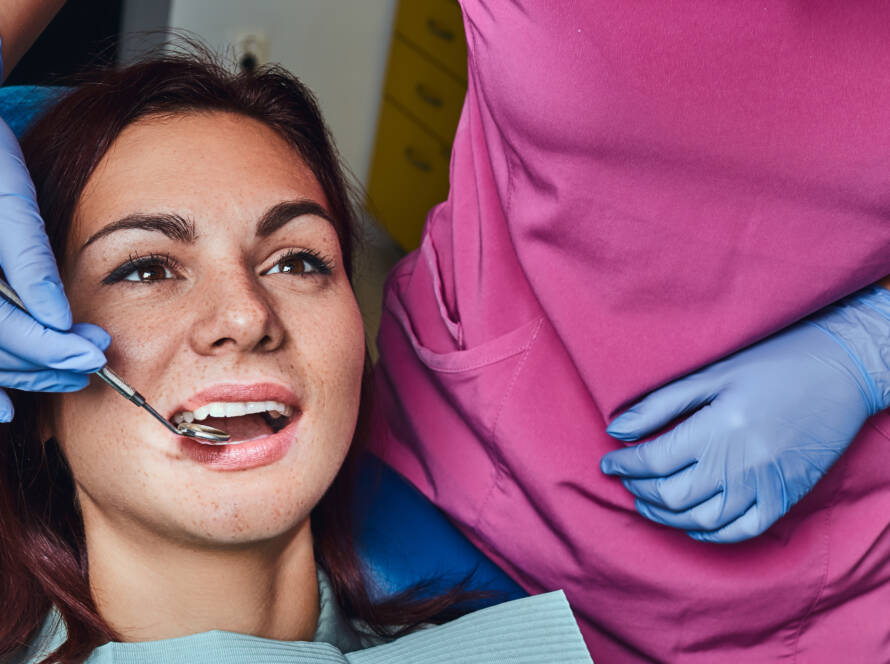Smile design refers to the process of improving the appearance of one’s smile through various dental procedures. It involves a detailed and customized plan that takes into account an individual’s unique dental and facial characteristics. The primary goal of smile design is to achieve a harmonious and aesthetically pleasing smile while also ensuring optimal dental function.
Key Components of Smile Design
- Facial Analysis:
- Evaluates the relationship between lips, teeth, and facial features.
- Includes assessing the symmetry and proportion of the face.
- Dental Analysis:
- Examines tooth color, shape, and alignment.
- Includes assessment of gum health and position.
- Functional Analysis:
- Ensures proper alignment and bite functionality.
- Identifies any issues that could affect oral health or lead to complications.
Processes Involved in Smile Design
- Consultation:
- Involves discussing the patient’s cosmetic goals and expectations.
- Includes reviewing the patient’s medical and dental history.
- Digital Smile Design (DSD):
- Utilizes digital technology to create a virtual model of the desired smile.
- Allows for precise planning and visualization of results.
- Treatment Planning:
- Combines various procedures to achieve the desired outcome.
- May include orthodontics, veneers, bonding, teeth whitening, and gum recontouring.
Tools and Technologies
- Intraoral Scanners:
- Used to capture detailed 3D images of teeth and gums.
- CAD/CAM Technology:
- Allows for the precise design and fabrication of dental restorations.
- 3D Printing:
- Produces highly accurate dental models and guides.
Considerations in Smile Design
- Patient’s Needs and Preferences:
- Aesthetic desires such as tooth color and shape.
- Clinical Feasibility:
- Assessing dental health to ensure long-term stability.
- Cost and Timeframe:
- Discussing the financial and temporal aspects of treatment options.
Smile design ultimately requires a comprehensive understanding of dental aesthetics, advanced technology, and effective communication between the dentist and the patient to deliver a personalized and functional solution.
The Importance of Personalized Aesthetic Solutions
Personalized aesthetic solutions in smile design consider individual characteristics and preferences, thereby optimizing patient satisfaction. Unlike generic treatments, personalized solutions enhance natural beauty and align with the unique dental structure and facial features of each patient.
Key elements include:
- Patient-Centered Approach:
- Detailed consultations to understand the patient’s aesthetic goals.
- Consideration of the patient’s oral health history and lifestyle.
- Advanced Diagnostic Tools:
- Utilization of 3D imaging technology for accurate representations.
- Digital smile design software to simulate potential outcomes.
- Custom Treatment Plans:
- Tailored plans that suit the functionality and aesthetics specific to each patient.
- Flexible solutions that adapt to any changes in patient needs or preferences.
- Enhanced Communication:
- Improved patient-dentist interactions through visual aids and mock-ups.
- Clear communication ensures alignment between expected and actual outcomes.
- Psychological Benefits:
- Boosts confidence by creating a smile that feels genuine and personally suited.
- Reduces anxiety associated with dental procedures through predictable results.
Benefits to consider:
- Precision: Personalized solutions achieve higher accuracy in both diagnosis and treatment, leading to superior aesthetic results.
- Adaptability: Treatment plans remain flexible, allowing adjustments tailored to ongoing patient feedback and changes in health.
- Satisfaction: Patients experience greater satisfaction with customized treatments that reflect their individual desires and intrinsic identity.
Challenges in implementation involve:
*Managing patient expectations through education about the realistic outcomes and limitations of aesthetic enhancements. *Balancing technological investments with the need for affordability without compromising on the quality of care.
By prioritizing individual needs through comprehensive assessments and cutting-edge technology, practitioners achieve exceptional outcomes in smile design.
Patient Assessment: The Foundation of Personalized Smile Design
Accurate patient assessment is crucial for developing personalized aesthetic solutions in smile design. Initial consultations should thoroughly evaluate the patient’s dental and facial structures, as well as their aesthetic goals. This comprehensive analysis involves several key steps:
- Medical and Dental History Review:
- Assess the patient’s overall health, focusing on any conditions that may impact dental treatment.
- Review dental history, including previous treatments, current oral health issues, and any ongoing concerns.
- Photographic Analysis:
- Take high-resolution photographs of the patient’s smile from multiple angles.
- Use these images to study lip dynamics, tooth display, and overall facial harmony.
- Radiographic Evaluation:
- Utilize radiographs to assess bone structure, tooth alignment, and any hidden pathologies.
- Incorporate 3D imaging for a more detailed examination of the dental arches and surrounding structures.
- Digital Impressions:
- Capture precise digital impressions to create accurate, virtual models of the patient’s teeth and gums.
- Use these models for simulation and visualization of treatment outcomes.
- Facial Analysis:
- Conduct a detailed examination of the patient’s facial features, including symmetry, proportions, and muscular function.
- Evaluate how the teeth and smile fit within the overall context of the patient’s face.
- Occlusal Analysis:
- Assess the patient’s bite and jaw function to identify any occlusal issues or underlying conditions.
- Ensure that the aesthetic treatments will not compromise functional integrity.
- Patient Interview:
- Discuss with the patient their aesthetic goals, preferences, and concerns.
- Understand the patient’s motivations and expectations to align treatment plans with their desired outcomes.
- Diagnostic Wax-Up and Mock-Ups:
- Create diagnostic wax-ups to visualize potential treatment results.
- Use temporary mock-ups to allow patients to experience and approve the proposed changes before finalizing the treatment plan.
- Interdisciplinary Consultation:
- Collaborate with specialists, such as orthodontists, periodontists, and oral surgeons, to address complex cases.
- Ensure comprehensive care and optimal results through a multidisciplinary approach.
Understanding the patient’s unique dental anatomy, facial features, and personal aspirations forms the cornerstone of personalized smile design. By integrating clinical data, patient input, and advanced imaging technologies, the practitioner can develop a tailored and effective treatment plan.
Diagnostic Tools and Technologies in Smile Design
Advanced diagnostic tools and technologies play a pivotal role in developing personalized aesthetic solutions in smile design. By leveraging these innovations, dentists can deliver precise, tailored results that align with each patient’s unique needs and preferences.
Digital Intraoral Scanners
Digital intraoral scanners capture high-resolution images of a patient’s teeth and gums, producing accurate digital impressions. These impressions allow for:
- Precise visualization of oral structures
- Enhanced communication between dental professionals and patients
- Streamlined workflows reducing the need for physical molds
Cone Beam Computed Tomography (CBCT)
Cone Beam Computed Tomography provides 3D imaging of the dental anatomy, offering comprehensive views necessary for:
- Accurate diagnosis of underlying dental issues
- Detailed treatment planning for complex cases
- Evaluation of bone density and structure for implant placement
Photogrammetry
Photogrammetry employs photographic techniques to analyze and map the surface of teeth and gums accurately. This technology enhances:
- Documentation of the current dental state
- Monitoring of treatment progress
- Virtual simulation of smile outcomes
Digital Smile Design (DSD) Software
Digital Smile Design software allows practitioners to create visual representations of potential treatment results. Features include:
- Simulation of various aesthetic scenarios
- Ability to make real-time adjustments
- Improved patient engagement through visual aids
Intraoral Cameras
Intraoral cameras provide detailed images of the oral cavity, instrumental in:
- Identifying potential issues not visible to the naked eye
- Educating patients on their dental conditions
- Enhancing diagnostic accuracy
Laser Technology
Laser technology has become integral in modern dentistry for its versatility and precision. Applications include:
- Soft tissue management for gingival recontouring
- Hard tissue procedures for decay removal
- Promotion of faster healing with minimal discomfort
Computer Aided Design/Computer Aided Manufacturing (CAD/CAM)
CAD/CAM systems enable the design and fabrication of dental restorations, such as crowns and veneers, with high precision. Their benefits encompass:
- Customization of dental prosthetics to individual specifications
- Significant reduction in turnaround times
- Consistency in high-quality restorative work
Artificial Intelligence (AI) and Machine Learning
AI and machine learning enhance diagnostic accuracy and treatment planning by analyzing vast datasets. These technologies aid in:
- Predictive analytics for treatment outcomes
- Automated identification of dental conditions
- Personalized treatment recommendations
In summary, the integration of these diagnostic tools and technologies fosters a more accurate, efficient, and patient-centric approach in the realm of smile design. These innovations support the creation of aesthetic solutions that not only enhance dental health but also improve overall patient satisfaction.
The Role of Digital Imaging and Software in Customizing Aesthetic Solutions
Digital imaging and software have revolutionized the process of developing personalized aesthetic solutions in smile design. These technologies contribute significantly by enhancing precision, efficiency, and patient satisfaction.
Key Contributions of Digital Imaging
- Enhanced Visualization: Digital imaging enables dentists to capture high-resolution images of a patient’s oral cavity. These images provide detailed visual information that facilitates accurate diagnosis and treatment planning.
- Predictive Modeling: Using advanced imaging techniques, practitioners can create predictive models of the patient’s treatment outcomes. These models help in anticipating potential issues and refining the treatment approach accordingly.
- Patient Communication: Digital images serve as an excellent tool for communication between the dentist and the patient. By visually representing the current and proposed state of the patient’s smile, it becomes easier for patients to understand and trust the treatment plan.
Role of Advanced Software
- Treatment Planning: Software tools assist in various stages of treatment planning, from initial consultation to the final execution. They provide a platform where different treatment options can be evaluated and compared.
- Simulation and Design: Various software applications allow for the simulation and design of dental restorations. Dentists can create digital mock-ups of veneers, crowns, and other aesthetic solutions, ensuring that they meet the specific requirements of each patient.
- Precision and Customization: With the aid of CAD/CAM software, dental professionals can achieve a high level of precision in designing and fabricating dental restorations. This technology ensures that each solution is customized to fit the unique anatomical features of the patient.
- Efficiency: Integrating digital tools in aesthetic dentistry significantly reduces the time required for treatments. This efficiency is beneficial for both the practitioners and the patients, making the overall process faster and more predictable.
Interdisciplinary Collaboration
Digital imaging and software also facilitate collaboration among different specialists involved in a patient’s care, such as orthodontists, periodontists, and prosthodontists. By sharing digital records and treatment plans, these professionals can coordinate efforts to provide comprehensive and cohesive care.
Future Trends
The evolution of digital imaging and software continues to push the boundaries of what is possible in aesthetic dentistry. Innovations such as AI-driven diagnostic tools and 3D printing are expected to further enhance the customization and efficiency of smile design processes.
In conclusion, the role of digital imaging and software in customizing aesthetic solutions cannot be overstated. These technologies have made it possible to deliver highly personalized, effective, and efficient treatments, setting new standards in the field of smile design.
Anatomical and Aesthetic Considerations: Balancing Form and Function
In the realm of smile design, careful attention must be granted to both anatomical and aesthetic factors to achieve a balanced and harmonious result. The anatomical elements concern the structural aspects of the teeth, gums, and jaw, whereas the aesthetic dimensions pertain to the overall visual appeal. This dual focus ensures that functional necessities are met without compromising on visual expectations.
Anatomical Considerations
- Tooth Alignment and Position: Proper alignment and positioning of teeth are critical to dental health. Misaligned teeth can lead to issues such as improper bite, enamel wear, and even temporomandibular joint (TMJ) disorders.
- Gum Health and Contour: Healthy and well-contoured gums provide the necessary support and aesthetic framework for teeth. Gum recession or overgrowth can detract from the appearance and functionality of the smile.
- Jaw Structure and Symmetry: The symmetry and structure of the jaw play a pivotal role in maintaining both oral function and facial aesthetics. Jaw misalignment can cause discomfort and affect the balance of the face’s appearance.
Aesthetic Considerations
- Tooth Shape and Size: Tailoring the shape and size of each tooth to fit the individual’s facial features ensures a natural and pleasing appearance. This involves adjusting the width, length, and curvature to achieve proportion and harmony.
- Color Matching: Selecting the appropriate tooth color is vital for creating a seamless and attractive smile. Various shades are considered, taking into account skin tone, eye color, and individual preferences.
- Smile Line: The smile line, which follows the curvature of the lower lip, plays a significant role in aesthetic appeal. A well-defined smile line enhances the visual flow and coherence of the teeth when smiling.
Balancing Form and Function
- Interdisciplinary Collaboration: Effective smile design requires a collaborative approach involving orthodontists, periodontists, and cosmetic dentists. Each specialist addresses distinct yet interrelated aspects to ensure holistic care.
- Personalized Treatment Plans: A personalized treatment plan should consider the patient’s unique anatomical structure and aesthetic desires. Comprehensive diagnostics and consultation lay the foundation for tailored interventions.
- Advanced Technology: Incorporating advanced technologies such as 3D imaging and digital mock-ups facilitates precise planning and execution. These tools enable practitioners to visualize and adjust the outcomes in real-time, ensuring optimal results.
In summary, the integration of anatomical and aesthetic considerations is fundamental to developing personalized aesthetic solutions in smile design. The process demands a meticulous and collaborative approach that honors the individuality of each patient while achieving both functional and visual excellence.
Materials and Techniques for Personalized Smile Makeovers
Materials and techniques in personalized smile makeovers are crucial for achieving the desired aesthetic outcomes. Dentists and dental technicians employ a range of resources to craft individualized solutions.
Materials
- Composite Resins: Composite resins are versatile, allowing for direct application and immediate results. They are ideal for minor corrections and affordable alternatives to more extensive treatments.
- Porcelain Veneers: Porcelain veneers offer superior aesthetics and durability. They are custom-made to mimic the natural tooth appearance, making them suitable for significant shape or color changes.
- Ceramic Crowns: Ceramic crowns provide strength similar to natural teeth, essential for restoring function while maintaining cosmetic appeal. These are commonly used in more serious restorative cases.
- Dental Implants: Implants consist of titanium posts and attached crowns, providing a long-term solution for missing teeth. They offer exceptional stability and are indistinguishable from natural teeth.
- Teeth Whitening Agents: Various professional-grade bleaching agents are employed to safely and effectively brighten discolored teeth. These agents can be tailored to individual sensitivity and desired shade.
Techniques
- Digital Smile Design (DSD): DSD involves sophisticated software to visualize and plan the patient’s optimal smile. It considers facial structure and esthetic proportions, allowing for precise customization.
- 3D Printing: 3D printing technology enables the creation of precise dental models and restorations. This technology enhances accuracy and reduces turnaround times for personalized treatments.
- Laser Dentistry: Lasers are used for a range of procedures including gum reshaping and cavity removal, offering precision and reduced healing times.
- Minimally Invasive Veneer Placement: This technique preserves more of the natural tooth while securely applying veneers. It emphasizes conservative preparations to maintain tooth integrity.
- Orthodontic Treatments: Clear aligners and braces are tailored to individual bite issues, gradually moving teeth into optimal positions. These methods ensure both aesthetic and functional improvements.
Combination Strategies
- Integrative Treatments: Combining various materials and techniques often yields superior results. For example, whitening prior to veneer application ensures a harmonious color match.
- Customized Treatment Plans: Dentists develop individualized plans based on a patient’s unique needs, employing a combination of techniques and materials to achieve the desired outcome.
Understanding and utilizing the appropriate materials and techniques is fundamental to achieving successful, personalized smile makeovers.
Collaborative Approach: Involving the Patient in the Design Process
A pivotal aspect of contemporary smile design is the collaborative approach, which actively involves the patient in the design process. This methodology ensures that the final outcome not only meets clinical standards but also aligns with the patient’s aesthetic preferences and personal goals.
Initial Consultation and Patient Education
The process begins with an initial consultation where practitioners aim to understand the patient’s desires and concerns. During this phase, various techniques are employed to educate the patient about potential treatment options, including:
- Visual Aids: Use of before-and-after images, diagrams, and digital animations to explain different procedures.
- Mock-Ups: Physical or digital mock-ups to provide a tangible preview of the potential results.
Comprehensive Patient Assessment
A thorough assessment is conducted to gather essential data. This involves:
- Clinical Examination: Assessing dental health, alignment, and occlusion.
- Photographic Analysis: Capturing high-resolution images to analyze facial symmetry and dental proportions.
- Digital Scanning: Using 3D scanners to create precise models of the patient’s mouth.
Collaborative Design Sessions
Patients are invited to participate directly in the design sessions, where they can:
- Provide Input on Aesthetics: Share preferences regarding tooth shape, color, and overall appearance.
- Review Digital Simulations: Assess proposed designs via computer software that simulates the post-treatment outcome.
Feedback Loop and Iterative Refinement
To ensure the final result aligns with the patient’s expectations, a feedback loop is established:
- Iterative Adjustments: Modify the design based on patient feedback and further clinical evaluation.
- Mock Trials: Conducting temporary trials, such as provisional crowns, to gauge the patient’s comfort and satisfaction.
Transparent Communication
Maintaining transparent communication throughout the process is crucial. This includes:
- Regular Updates: Keeping the patient informed about progress and any potential changes.
- Question-and-Answer Sessions: Offering opportunities for patients to voice concerns and ask questions.
Empowering Patient Autonomy
Ultimately, the collaborative approach empowers patient autonomy, ensuring that individuals feel actively involved in decisions that impact their personal aesthetic and dental health. This patient centered method not only enhances satisfaction but also fosters a strong practitioner-patient relationship grounded in trust and mutual respect.
Addressing Common Challenges in Smile Design
Smile design involves navigating a myriad of potential challenges to achieve the desired aesthetic outcome. Recognizing and addressing these hurdles in an efficient manner contributes significantly to the success of the process.
Patient Expectations and Communication
- Understanding Patient Goals: Clear communication between the dentist and the patient is paramount. Misunderstandings can lead to dissatisfaction with the final result.
- Managing Realistic Outcomes: Patients often have expectations that may not be feasible. Educating them about what can realistically be achieved is crucial.
Technical and Anatomical Constraints
- Dentition Issues: Problems such as tooth decay, gum disease, or misaligned teeth can complicate the design process. Comprehensive dental health must be assessed before proceeding.
- Anatomical Limitations: Variations in jaw structure and facial symmetry can present challenges. Custom solutions must be designed to address these unique anatomical features.
Material Selection
- Durability vs. Aesthetics: Selecting the right materials requires balancing aesthetic desires with practical needs for durability.
- Biocompatibility: The materials chosen should be safe and non-reactive for the patient. Incorrect material selection can lead to allergic reactions or other complications.
Technological Integration
- Advanced Imaging: Proper utilization of digital imaging technologies can provide more accurate representations of potential outcomes.
- Software Limitations: Existing software may not always completely adapt to every individual’s unique anatomy. This can necessitate manual adjustments by skilled practitioners.
Time and Cost Management
- Project Timeline: Smile design procedures can be time-consuming. It’s important to set realistic timelines to manage patient expectations.
- Cost Considerations: Patients need to be made aware of the financial investment required for successful smile design. Transparent billing practices enhance patient trust.
Psychological Factors
- Self-esteem Issues: Addressing the psychological state of the patient is integral to the process. A confident and satisfied patient results from a design that meets their emotional as well as physical needs.
- Fear and Anxiety: Many patients experience dental anxiety. Creating a comfortable and reassuring environment helps alleviate these fears.
By meticulously addressing these common challenges, practitioners can develop personalized aesthetic solutions that meet patients’ needs effectively and proficiently.
Future Trends in Personalized Aesthetic Solutions for Dentistry
Emerging trends in dental aesthetics are set to revolutionize personalized smile design. Key developments include:
- AI Integration: The incorporation of artificial intelligence (AI) in diagnostic imaging and treatment planning is enhancing precision. AI algorithms analyze patients’ facial structure to suggest optimal smile designs.
- 3D Printing: Advances in 3D printing technology allow for customized dental models and prosthetics. This ensures unique, patient-specific solutions with quicker turnaround times.
- Augmented Reality (AR): AR applications provide predictive visuals of post-treatment results. Patients can visualize potential outcomes, increasing satisfaction and improving decision-making.
- Biocompatible Materials: The development of advanced, biocompatible materials for restorations offers enhanced durability and aesthetics. These materials are designed to mimic natural teeth more closely, both in function and appearance.
- Digital Smile Design (DSD): Predictive analytics in DSD software generate detailed, personalized treatment plans. Professionals can customize procedures with high accuracy, tailored to individual anatomical and aesthetic needs.
- Minimally Invasive Techniques: There is a shift towards procedures that maintain more of the original tooth structure. Techniques such as microabrasion, laser dentistry, and no-prep veneers are becoming more prevalent.
- Collaborative Platforms: Online platforms facilitate collaboration among dental professionals, enabling the sharing of expertise and insights. This enhances the development and implementation of personalized solutions.
- Patient-Centric Software: Tools that engage patients directly in the design process are on the rise. They allow patients to provide input on aesthetics, leading to higher satisfaction rates.
- Genetic Profiling: Future potential lies in genetic profiling to predict and enhance dental health outcomes. Personalizing aesthetics at the genetic level may soon become a reality.
These trends indicate a future where dental aesthetics are more personalized, efficient, and driven by technological advancements. The goal is to achieve higher precision, better patient outcomes, and increased satisfaction in smile design.
Conclusion: Enhancing Patient Confidence through Personalized Smile Design
Enhancing patient confidence through personalized smile design involves a meticulous approach tailored to individual needs and desires. Every step, from initial consultation to final adjustments, must prioritize the patient’s unique facial characteristics, dental history, and aesthetic goals. The process integrates advanced digital imaging and simulation technologies to provide a visual representation of expected outcomes. This allows patients to engage actively in their treatment plans, ensuring alignment with their expectations.
Key elements in enhancing confidence include:
- Comprehensive Assessments: A thorough assessment of dental health, facial symmetry, and patient preferences lays the groundwork for an effective smile design.
- Patient Involvement: Engaging patients through detailed discussions and visual aids increases their understanding and comfort levels.
- Technological Integration: Utilizing cutting-edge technology such as 3D imaging and smile simulation software provides a clear picture of potential results.
- Customized Treatment Plans: Individualized plans cater to the specific aesthetic and functional requirements of each patient, enhancing satisfaction with the final outcome.
Professionals must maintain open communication channels, allowing patients to voice their concerns and preferences throughout the process. This collaborative approach fosters trust and alleviates anxiety, as patients feel a sense of ownership over their treatment journey. Additionally, continuous education on the benefits and realistic capabilities of smile design procedures can demystify the process, further boosting patient confidence.
Ultimately, the goal is to deliver results that not only enhance appearance but also improve overall oral health and functionality. The synergy of artistic vision and clinical expertise ensures that personalized smile design is a transformative experience, instilling confidence and elevating quality of life. By focusing on these core aspects, dental professionals can significantly impact patient self-esteem and satisfaction, establishing a reputation for excellence in aesthetic dentistry.















